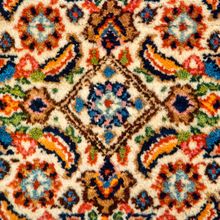Birjand Rug
| Birjand Rug | |
|---|---|
 Design of Birjand Rug (Rugman) | |
| General information | |
| Name | Birjand Rug |
| Original name | قالی بیرجند |
| Alternative name(s) | Birjand Carpet |
| Origin | |
| Category | City |
| Technical information | |
| Common designs | Medallion |
| Common colors | Red, Crimson, Cream, Navy Blue, Beige |
| Dyeing method | Natural, Synthetic |
| Pile material | Wool |
| Foundation material | Cotton |
| Knot type | Asymmetrical (Persian) |
Birjand rugs originate from Birjand. Located in the southern part of the Province of Khorasan, it has a history dating back more than 2000 years. Its population of nearly 120,000 people own approximately 18,000 carpet looms weaving magnificent area rugs reputed to be the finest produced in eastern Iran. The knot style used on Birjand rugs is the Persian asymmetrical knot, due in large part to the fact that area rugs woven with this knot tend to be more accurate and symmetrical. Birjand's rugs are famous and known internationally as "Mood Carpet". Mood is the name of a region in Birjand and the rug weaving style is unique to that region.
History
Birjand is a city located in eastern Iran and was once part of the largest Persian province, historically referred to as Greater Khorasan. The city name was called Mahestan. Today Birjand is the capital of the South Khorasan Province and is the second-most populated city in eastern Iran after Meshad.
Birjand carpets are known in the market from the late nineteenth century and are traded as Khorasan or Meshad carpets. They have a cotton foundation and a wool pile tied with the Persian (asymmetric) knot. During the nineteenth and early twentieth centuries Birjand weavings were known as a lower-quality Khorasan or Meshad carpet. The floral designs and coloration are similar to that in Khorasan and Meshad styles. Birjands generally have either medallion or allover designs, with Shah Abbas palmette motifs.
After World War II many Birjand weavers switched to the Herati (fish) pattern with a Pange Matn style. The Pange Matn design has five concentric lozenge medallions on the field. The outermost medallion appears in the four corners of the carpet field adjacent to the borders. These Birjand carpets were made with high grade quality and woven under the supervision of the aristocratic Amir Asadollah Alam family, which has lived in Birjand for generations. Amir Asadollah Alam (1919-1978) was a minister of the royal court under Mohammad Reza Shah Pahlavi and prime minister of Iran from 1962 to 1964. He was a highly respected politician and generous benefactor, especially in the Khorasan region. For decades Birjands were woven and successfully marketed as floor coverings domestically and for export. In the last quarter of the twentieth century Birjand weavers began to incorporate traditional Persian motifs, such as the Shah Abbas and Boteh (paisley) with the Pange Matn style.
Baluch rugs are brought from the surrounding region to the Birjand bazaar, which brings higher prices than the local markets. Birjand carpets and Baluch rugs were shipped daily to the Meshad and Tehran bazaars for domestic and export sale.
Birjand carpets made between the nineteenth century and World War II have traditional Khorasan coloration, with red-blue or dark blue for the background. In addition to these colors, different shades of brown, ivory, turquoise, and gold were used for the borders, design elements, and at times, in the field. Postwar coloration included lighter colors such as gold, turquoise, greens, and ivory, along with red and blue. Combinations of these colors were used for the Pange Matn background and borders.
The formats range from mats to large room-size carpets.[1]
See also
| Search for Birjand Rug on Wikipedia. |
References
- ↑ Moheban, 2015, 112
Bibliography
- Abraham Levi Moheban. 2015. The Encyclopedia of Antique Carpets: Twenty-Five Centuries of Weaving. NewYork: Princeton Architectural Press.